Willow trees are known for their graceful beauty, fast growth, and adaptability to various environments. With their arching branches, elegant foliage, and seasonal charm, these trees have become a favorite in landscapes, wetlands, and gardens around the world. But did you know there are many different types of willow trees, each with its own unique characteristics and growing habits?
From towering weeping willows to compact alpine varieties, the diversity within the willow genus (Salix) is truly remarkable. Some species thrive along riverbanks, while others grow in cold alpine zones or serve practical purposes like basket weaving and erosion control. Learning to identify the various types of willow trees can enhance your appreciation for their role in both ornamental and ecological landscapes.
In this guide, we’ll explore 37 fascinating types of willow trees, complete with pictures and identifying features. Whether you’re a gardener, nature lover, or simply curious about these versatile trees, this comprehensive list will help you discover the wide range of willows that exist across the globe.
Types of Weeping Willow Trees
Babylon Weeping Willow (Salix babylonica)

The Babylon Weeping Willow is one of the most iconic willow trees, known for its long, graceful branches that sweep toward the ground. Its narrow, lance-shaped leaves are bright green during spring and summer, turning golden yellow in fall. This species is fast growing and highly ornamental, often found near water features or large open lawns.
It thrives in USDA hardiness zones 5 through 9 and prefers full sun to partial shade. It grows best in moist, well-drained soil but can tolerate short periods of drought once established. Although originally native to China, the Babylon Willow has become widely cultivated in temperate regions around the world.
Regular watering is essential, especially in hot or dry climates, to maintain its lush appearance. Pruning in late winter or early spring helps maintain its shape and remove dead wood. It is best to plant this tree away from structures and pipes due to its aggressive root system.
Golden Weeping Willow (Salix × sepulcralis ‘Chrysocoma’)

The Golden Weeping Willow is admired for its brilliant golden yellow twigs and cascading green foliage, making it a standout feature in any landscape. It is a hybrid variety developed from Salix alba and Salix babylonica, combining hardiness with elegance. In early spring, it also produces small, inconspicuous catkins.
This willow thrives in USDA zones 4 through 9 and enjoys sunny areas with moist, rich soils. It is a fast growing tree that can reach 30 to 50 feet in height with a similar spread, making it suitable for large properties. Its golden twigs add winter interest even when the leaves are gone.
Golden Weeping Willow benefits from regular watering, especially in dry periods. It is relatively low maintenance but should be pruned annually to remove dead or weak branches. Avoid planting near septic systems or foundations due to its invasive roots.
Corkscrew Willow (Salix matsudana ‘Tortuosa’)

The Corkscrew Willow, also known as Dragon’s Claw Willow, is notable for its uniquely twisted branches and contorted leaves that give it an eye catching, sculptural appearance. It is often used in floral arrangements and winter gardens because of its dramatic shape. Its foliage is bright green in summer and turns yellow in the fall.
This willow is hardy in USDA zones 4 through 8 and grows quickly, typically reaching 20 to 30 feet tall. It adapts well to a variety of soil types but prefers moist, well-drained conditions and full sun. Originating from northern China, it is a cultivar of the Chinese Willow (Salix matsudana).
Caring for a Corkscrew Willow involves watering regularly during dry spells and pruning to control its shape. Its rapid growth makes it prone to weak branches, so removing damaged limbs helps prevent breakage. It is a great choice for ornamental use but should not be planted near underground utilities.
Common Weeping Willow Hybrid (Salix × pendulina)
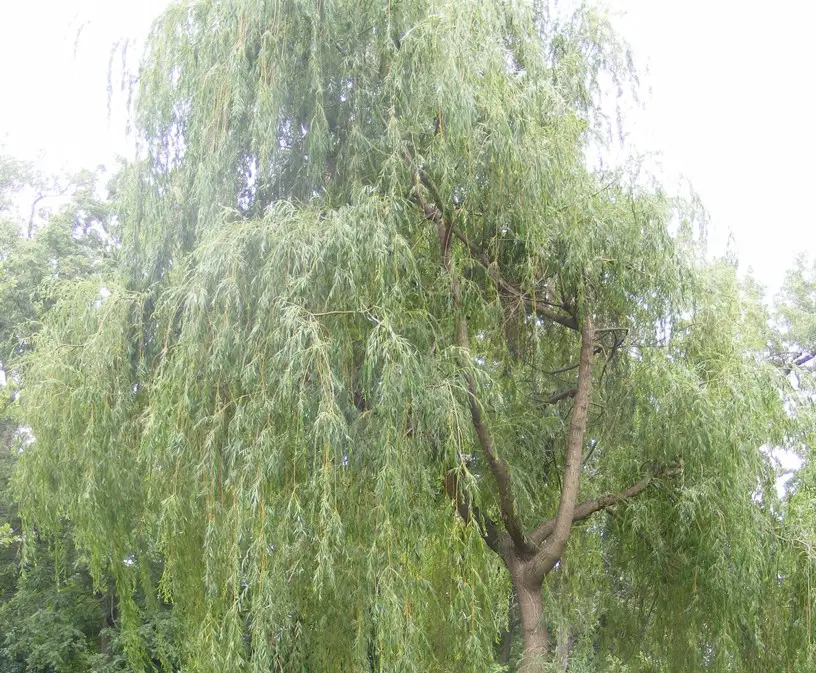
The Common Weeping Willow Hybrid is a widely planted ornamental tree known for its cascading branches and lush green foliage. This hybrid combines the beauty of traditional weeping willows with greater cold tolerance and adaptability. It adds elegance to parks, water edges, and large gardens.
It performs best in USDA hardiness zones 4 through 9 and prefers moist, loamy soil. The tree grows quickly, reaching 40 to 60 feet in height, and needs ample space to develop its expansive canopy. While tolerant of wet conditions, it may also survive in moderately dry soils once established.
To maintain its health, water regularly during dry periods and prune dead or crossing branches in early spring. Like other willows, this hybrid has aggressive roots and should be kept away from foundations, septic lines, and sidewalks. It is ideal for adding shade and drama to landscape designs.
Navajo Weeping Willow (Salix matsudana ‘Navajo’)

The Navajo Weeping Willow is a refined selection of the Chinese Willow, appreciated for its narrower, more upright form and graceful drooping limbs. Its leaves are lance-shaped, medium green, and turn yellow before shedding in autumn. This cultivar is a great choice for ornamental planting where space is more limited.
It grows well in USDA zones 4 through 9 and prefers full sun and moist, well-drained soils. The Navajo variety reaches about 30 to 40 feet tall, slightly smaller than other weeping willows, making it easier to manage in smaller landscapes. Its growth rate is fast and it tolerates urban pollution and compacted soil better than many willows.
Navajo Weeping Willow requires moderate watering and benefits from mulching to conserve moisture. Pruning once a year keeps its form elegant and promotes healthy branching. Its less invasive root system makes it more adaptable for residential gardens, though care should still be taken with placement.
Types of Shrub Willows
Purple Osier Willow (Salix purpurea)

The Purple Osier Willow is a striking deciduous shrub or small tree recognized for its slender purplish stems and narrow blue green leaves. It is often used for ornamental hedges, basket weaving, and erosion control due to its dense growth and pliable branches. In early spring, it produces slender catkins that add seasonal interest before the foliage appears.
This willow thrives in USDA hardiness zones 4 through 8 and grows well in full sun to partial shade. It prefers moist, well-drained soils but is also tolerant of heavy clay and wet conditions. Native to Europe and western Asia, it has naturalized in many parts of North America and is popular in landscape designs that favor structure and color contrast.
Purple Osier Willow benefits from regular pruning to maintain shape and encourage new growth. It is relatively low maintenance and grows quickly, typically reaching 10 to 20 feet tall. Its roots are non-invasive, making it suitable for residential gardens and riparian restoration.
Dappled Willow (Salix integra ‘Hakuro Nishiki’)
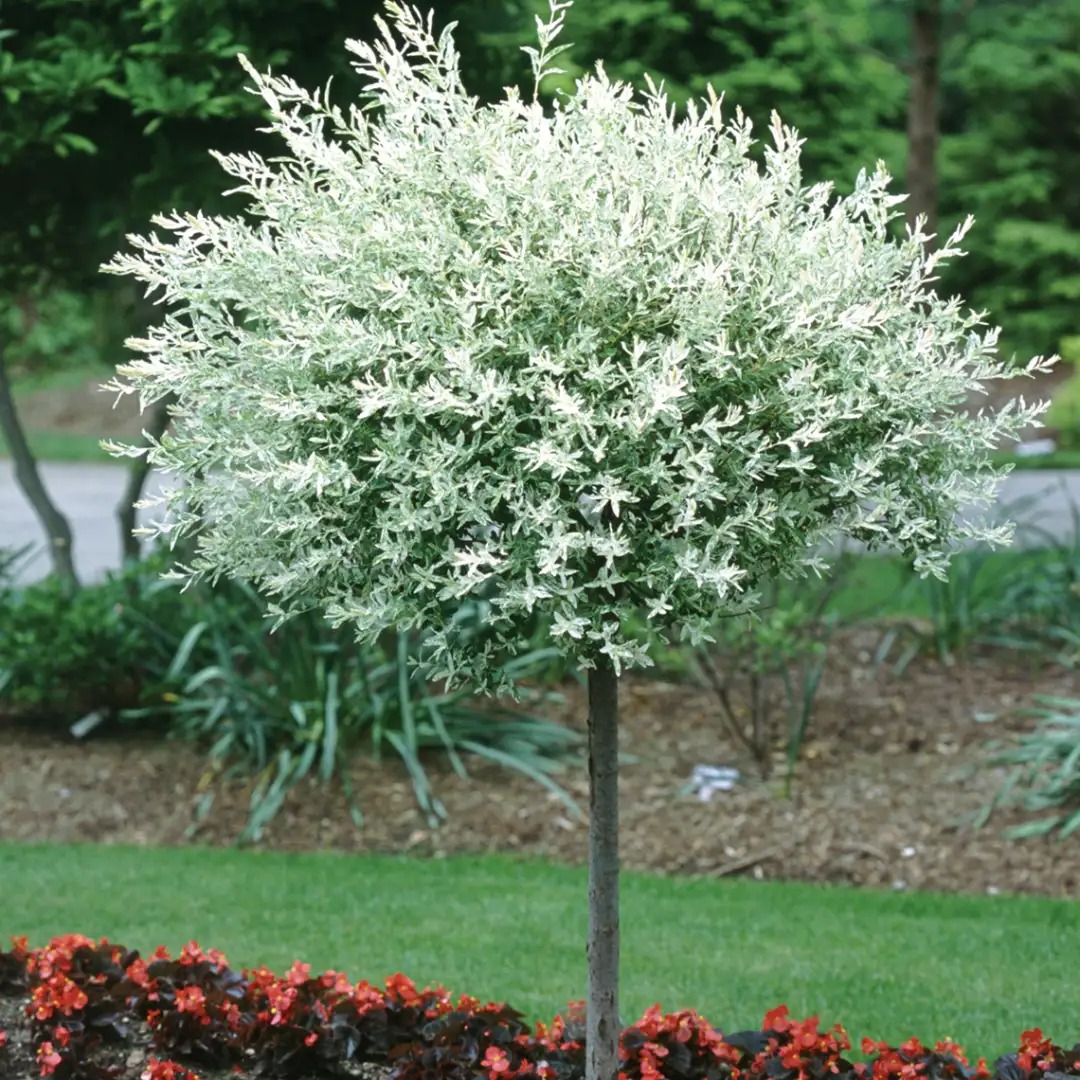
The Dappled Willow is an eye catching ornamental shrub known for its variegated foliage, which features a mix of white, pink, and green in spring and early summer. Its new growth emerges with a soft pink hue before maturing to green and cream. The branches are slender and arch gracefully, giving it a delicate appearance.
Hardy in USDA zones 4 through 9, this willow thrives in full sun to part shade and prefers consistently moist, well-drained soil. It typically grows to about 6 to 10 feet in height and width, making it an excellent choice for foundation plantings, borders, or container gardens. It responds well to shaping and rejuvenation pruning.
Regular watering helps maintain its vibrant foliage, especially during dry spells. Pruning in late winter or early spring enhances its variegation and keeps the plant compact. Though not invasive, it benefits from occasional thinning to prevent overcrowding and maintain good air circulation.
Mountain Willow (Salix arbuscula)
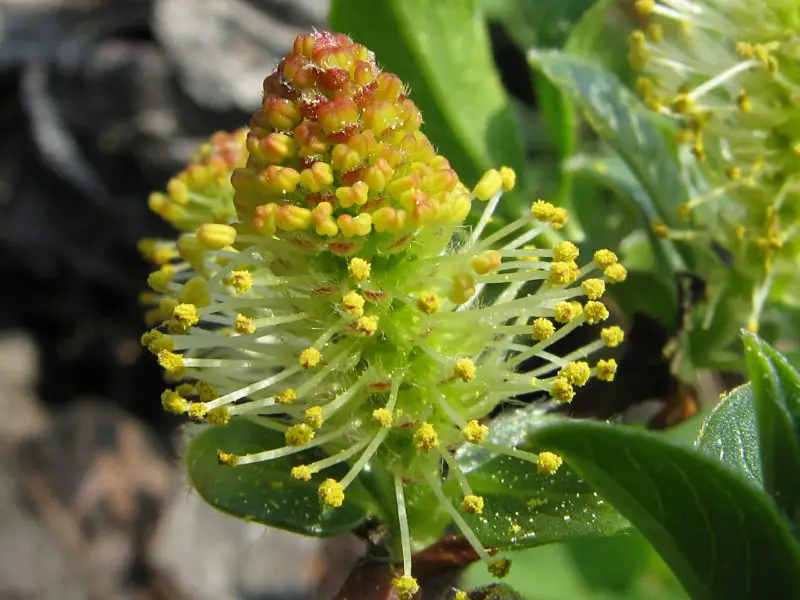
The Mountain Willow is a compact deciduous shrub native to upland and alpine regions of northern Europe. It is prized for its small rounded leaves with fine serration and its tolerance for cold climates and poor soils. In spring, it produces modest yellowish catkins that attract pollinators.
This hardy willow grows well in USDA zones 2 through 6 and is perfectly suited for rock gardens, alpine landscapes, and high elevation environments. It stays low to the ground, typically reaching only 2 to 4 feet in height, and spreads slowly. It thrives in full sun and well drained soils, often preferring slightly acidic conditions.
Mountain Willow requires minimal care once established. Occasional watering during dry periods helps maintain vigor, and light pruning may be done to shape the plant or remove dead growth. Its small stature and resilience make it a great addition to cold climate gardens with limited space.
Coyote Willow or Narrowleaf Willow (Salix exigua)
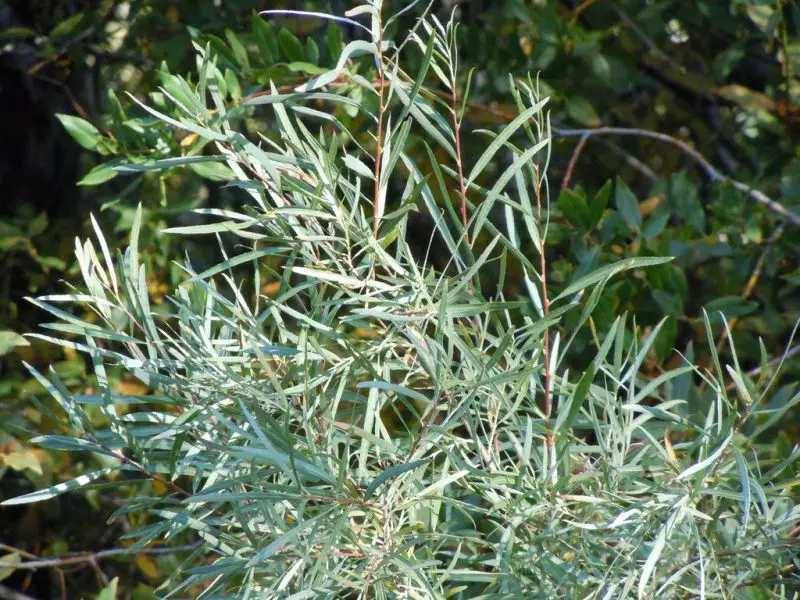
Coyote Willow, also known as Narrowleaf Willow, is a slender, thicket forming willow native to much of North America. It is recognized for its narrow gray green leaves and silvery appearance. This fast growing shrub is commonly found along streams, rivers, and wetlands and plays a key role in stabilizing soil and supporting wildlife.
This species grows well in USDA hardiness zones 3 through 9 and thrives in full sun and wet or seasonally flooded soils. It can reach 10 to 20 feet tall but is often pruned lower. Its growth is dense and suckering, forming colonies that are ideal for erosion control or naturalizing landscapes.
Coyote Willow needs regular moisture and spreads easily through underground rhizomes. It benefits from occasional thinning to manage spread and maintain airflow. It is not suited for small spaces but excels in natural or restoration plantings where it can grow freely.
Blueberry Willow (Salix myrtillifolia)
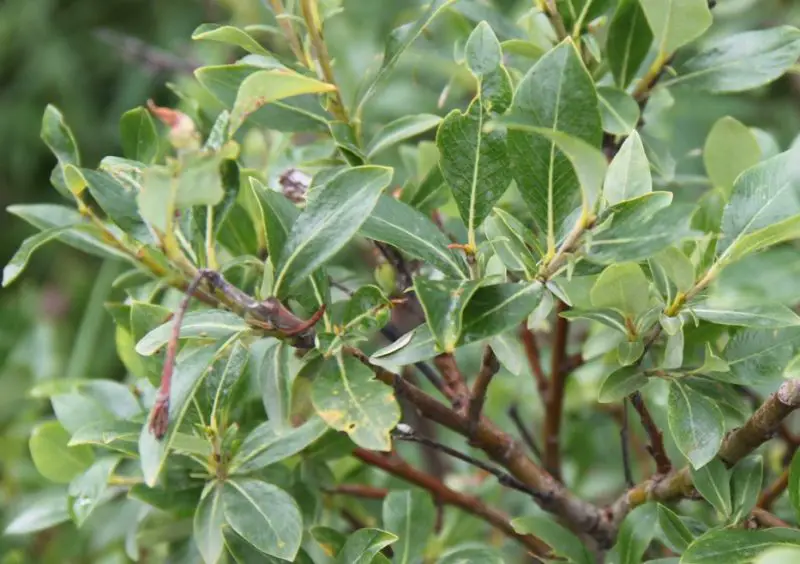
The Blueberry Willow is a small to medium sized shrub with oval leaves that resemble those of blueberry plants, hence its name. The foliage is dark green with a glossy texture and turns yellow in fall. This northern species is adapted to cold climates and wetland areas, often found near bogs and lakeshores.
It is hardy in USDA zones 2 through 6 and prefers moist to wet soils with good drainage. Blueberry Willow grows 3 to 6 feet tall and spreads gradually, making it ideal for native plant gardens, wetlands, or as a border in cooler regions. It tolerates partial shade but performs best in full sun.
Blueberry Willow requires minimal maintenance aside from ensuring consistent moisture. It can be pruned to shape or rejuvenate the plant every few years. Its non-invasive roots and adaptability to wet soils make it a great choice for ecological landscaping and wildlife gardens.
Net Leaved Willow (Salix reticulata)
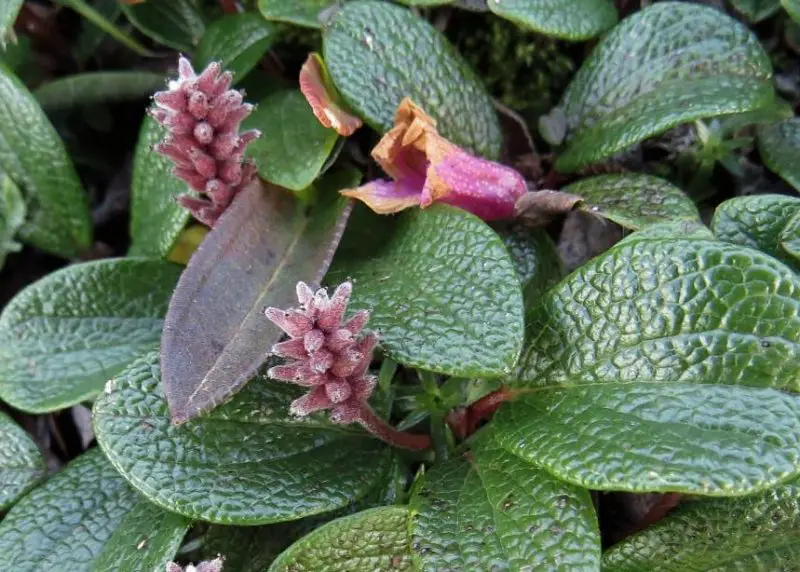
Net Leaved Willow is a low growing, mat forming shrub with distinctive leaves that display a network of raised veins on their surface, giving the plant its name. The foliage is dark green and glossy above, pale and slightly hairy underneath. It is well suited to rocky, alpine terrain where few other shrubs can survive.
This species thrives in USDA hardiness zones 2 through 6 and is native to mountainous and arctic regions of Europe, Asia, and North America. It typically reaches only 2 to 4 inches in height but can spread widely, making it excellent for ground cover in rock gardens and cold climate landscapes. It prefers full sun and well drained, slightly acidic soils.
Net Leaved Willow requires little maintenance once established. Occasional watering during dry spells helps maintain its vigor. Pruning is rarely needed, but trimming back older stems in early spring can help promote new growth and maintain a tidy appearance.
Creeping Willow (Salix repens)

Creeping Willow is a low spreading shrub with slender stems and small, narrow leaves that vary from green to silvery gray depending on the variety. It is often used in landscaping for erosion control and ground cover, especially in sandy or coastal environments. In spring, it produces small catkins that add seasonal interest.
This species grows well in USDA zones 4 through 7 and prefers full sun and moist, well drained soils. Native to Europe and parts of western Asia, it reaches a height of 1 to 3 feet and spreads via underground stems, making it ideal for stabilizing banks or filling in wide open spaces.
Creeping Willow benefits from regular watering during establishment and in dry weather. It can be pruned to control its spread or to shape the plant as desired. Its ability to thrive in poor soils and exposed sites makes it a reliable option for difficult landscapes.
Woolly Willow (Salix lanata)

Woolly Willow is a hardy, slow growing shrub known for its soft, densely hairy leaves that give it a silvery, velvety texture. Its compact shape and fuzzy foliage make it highly attractive in alpine gardens and cold climate settings. It also bears yellowish catkins in early spring.
This species is native to northern Europe and parts of the Arctic and is well suited to USDA zones 2 through 6. It usually reaches 3 to 5 feet in height and prefers full sun and cool, moist, well drained soil. Its tolerance for wind and cold makes it ideal for exposed sites or high elevation gardens.
Woolly Willow is low maintenance, requiring only occasional watering and minimal pruning. Trimming dead or old wood in early spring keeps it healthy and compact. Its unique appearance and hardiness make it a standout choice in specialty or wildlife gardens.
Arctic Willow (Salix arctica)

Arctic Willow is a dwarf species that grows close to the ground and is adapted to some of the harshest climates on Earth. Its rounded leaves are dark green with a silvery underside, and its branches are often hidden among mosses and rocks. It produces small reddish or yellow catkins in spring.
This willow is native to the Arctic tundra of North America, Europe, and Asia and is hardy in USDA zones 1 through 5. It typically grows only a few inches tall and forms spreading mats, making it ideal for rock gardens, alpine plantings, or cold climate restoration projects. It prefers full sun and moist, well drained soil.
Arctic Willow needs little care and is extremely cold tolerant. Supplemental watering may be needed in unusually dry conditions. It is an excellent plant for showcasing hardiness and resilience in extreme environments while offering habitat for arctic wildlife.
Dwarf Willow (Salix herbacea)
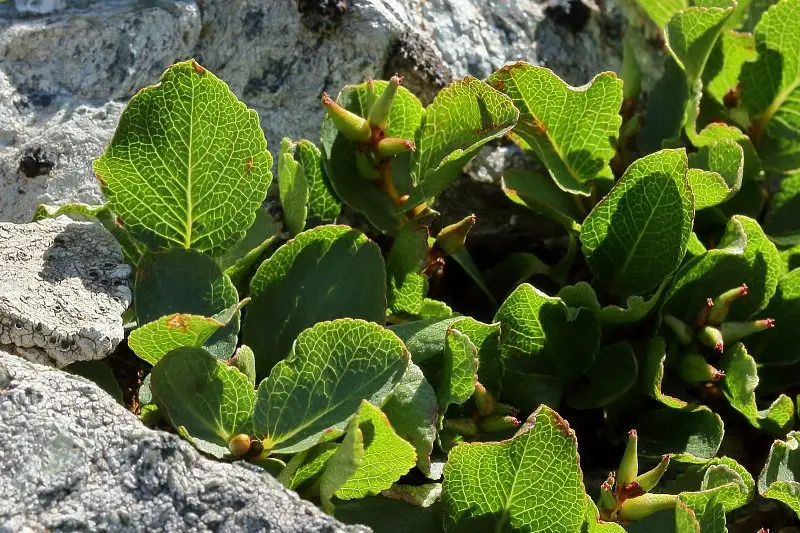
Dwarf Willow is one of the smallest woody plants in the world, growing just 1 to 2 inches tall. It has tiny rounded leaves and reddish catkins that emerge close to the ground. Its creeping growth habit allows it to survive in cold, wind swept environments such as tundras and alpine slopes.
This species thrives in USDA zones 1 through 5 and is native to high mountain and arctic regions of Europe and North America. Despite its tiny stature, it forms dense, spreading mats that help protect the soil from erosion and support other alpine flora. It prefers full sun and moist, well drained soils with good organic content.
Dwarf Willow is exceptionally low maintenance and extremely cold hardy. It benefits from occasional watering during dry spells but requires little else. Its unique miniature growth makes it perfect for rock gardens, alpine troughs, and educational plant displays focused on extreme habitat adaptations.
Tree Willows
White Willow (Salix alba)
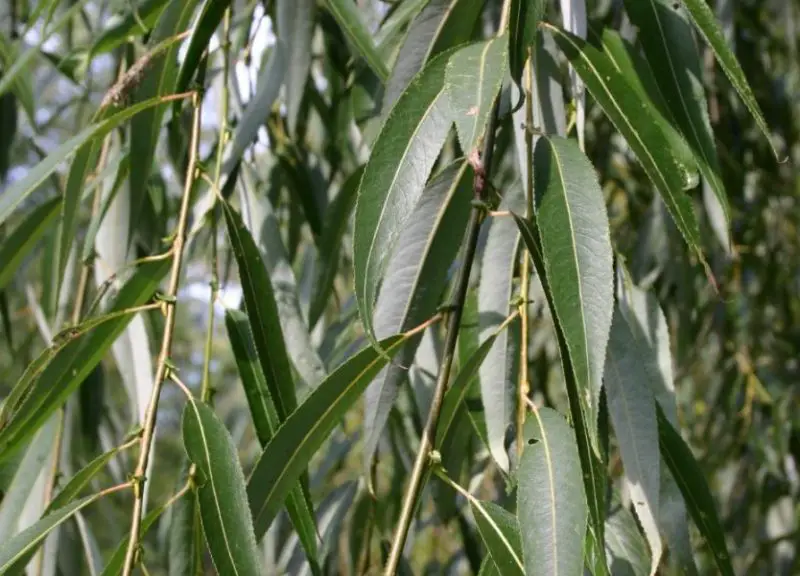
White Willow is a tall, graceful tree named for the pale, silvery undersides of its narrow leaves. It has a broad, open crown and is often found near rivers and wetlands, where its roots help prevent soil erosion. In spring, it produces yellowish catkins, adding subtle seasonal interest.
This species grows best in USDA hardiness zones 4 through 9 and thrives in full sun with moist to wet soil conditions. Native to Europe and western Asia, it can reach heights of 50 to 80 feet. It is commonly planted in riparian restoration projects and large landscapes for its fast growth and attractive foliage.
White Willow needs regular watering, especially in dry periods, and benefits from occasional pruning to remove damaged branches. It is best suited for spacious sites due to its size and spreading roots. Historically, the bark of this willow has been used for its medicinal properties.
Crack Willow (Salix fragilis)

Crack Willow gets its name from the brittle branches that break off easily, often with a cracking sound. It is a fast growing tree with bright green leaves and a rounded crown. This species commonly grows along riverbanks and lakes, forming thickets that support wildlife.
Hardy in USDA zones 4 through 8, Crack Willow prefers full sun and wet soils but can tolerate brief periods of drought once established. It can grow up to 60 feet tall and spreads easily through broken branches that take root in moist soil. Native to Europe and western Asia, it has naturalized in many parts of North America.
While it is useful for erosion control, Crack Willow can become invasive in certain areas. It should be pruned regularly to manage its shape and prevent overgrowth. Because of its rapid growth and weak wood, it is best planted away from structures or utility lines.
Black Willow (Salix nigra)
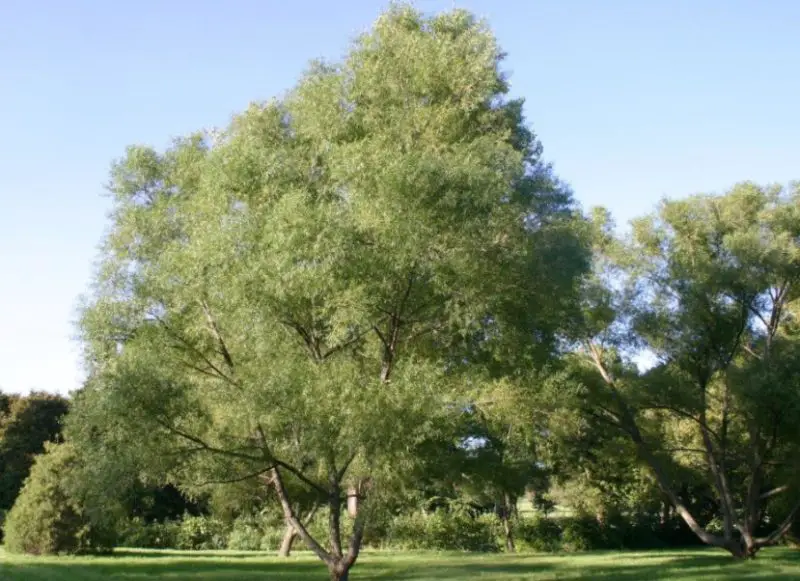
Black Willow is the largest native willow in North America and is distinguished by its dark, furrowed bark and long, slender leaves. It typically grows in floodplains, swamps, and along streams, where it stabilizes soil and supports aquatic habitats. Its catkins emerge in early spring before the leaves.
This species is hardy in USDA zones 4 through 9 and thrives in full sun with wet to saturated soils. It can grow 30 to 60 feet tall and spreads via both seeds and suckers. Black Willow is often used in ecological restoration and riparian buffer zones due to its environmental benefits.
Black Willow needs regular water and can tolerate periodic flooding. It benefits from pruning to remove weak or storm damaged branches. While it grows rapidly, its wood is soft, making it less ideal for urban areas but excellent for wildlife-focused and conservation plantings.
Bay Willow (Salix pentandra)

Bay Willow is a medium sized deciduous tree known for its shiny, dark green leaves that resemble those of the bay laurel. It produces fragrant yellow catkins in late spring and has a neat, upright growth habit, making it suitable for ornamental planting in moist environments.
Native to northern Europe and western Asia, Bay Willow thrives in USDA zones 4 through 7. It typically grows 20 to 40 feet tall and prefers full sun to partial shade with moist, well drained soils. It is commonly found near lakes, rivers, and lowland meadows.
This willow is relatively low maintenance and can be pruned to shape or rejuvenate the crown. Its attractive foliage and tidy form make it a good candidate for parks, large gardens, and water gardens. Regular watering ensures healthy growth, especially during dry summers.
Goodding’s Willow (Salix gooddingii)
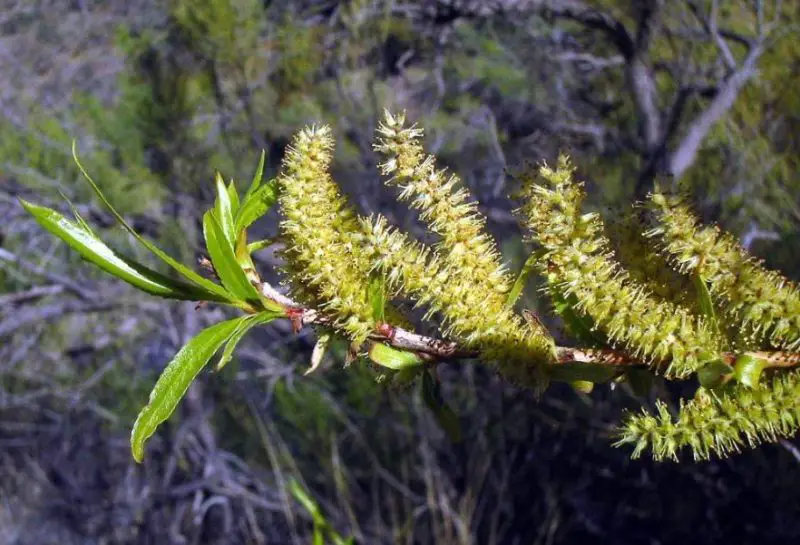
Goodding’s Willow is a fast growing riparian tree native to the southwestern United States and northern Mexico. It has broad, lance shaped leaves with a glossy green surface and a grayish underside. The tree provides vital habitat for birds and insects and is often found along streams and riverbanks.
This species is suited to USDA hardiness zones 6 through 9 and thrives in full sun with consistently moist or wet soils. It can grow up to 40 to 60 feet tall and is commonly used in restoration projects in arid and semi arid regions due to its adaptability to streamside conditions.
Goodding’s Willow requires regular watering, especially in dry climates, and benefits from occasional pruning to maintain structure and remove deadwood. Its fast growth and soil stabilization capabilities make it ideal for conservation areas and riparian buffers.
Humboldt Willow (Salix humboldtiana)
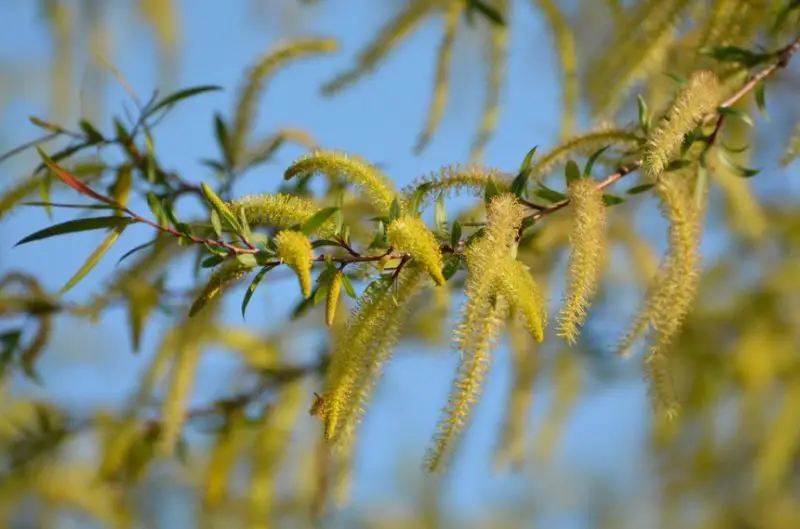
Humboldt Willow is a tall, elegant tree native to Central and South America, especially found near rivers, wetlands, and lakeshores. It features long, narrow, bright green leaves and a slightly weeping form, giving it a graceful, tropical appearance. Its catkins are small and often inconspicuous but appear in early spring.
This species grows well in USDA hardiness zones 8 through 10, thriving in full sun and moist to wet soils. Humboldt Willow can reach heights of 40 to 70 feet and is especially well adapted to subtropical and tropical regions. It is commonly found along river valleys and is used for erosion control and habitat restoration.
Care for Humboldt Willow includes regular watering to maintain moist soil, especially during dry periods. It may benefit from light pruning to manage shape or remove weak branches. Its tolerance for flooding and rapid growth make it a good choice for streambank stabilization projects in warm climates.
Shining Willow (Salix lucida)
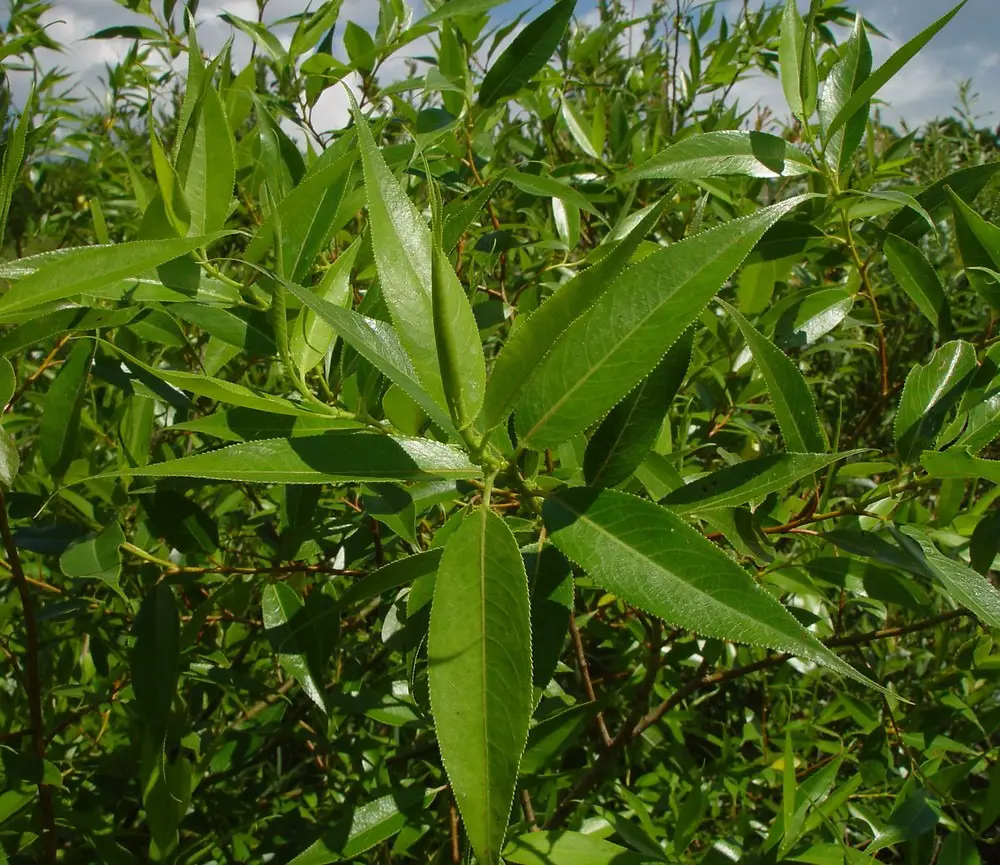
Shining Willow is known for its glossy, lance shaped leaves that shimmer in the sunlight, giving the tree its name. It has a narrow, upright form and produces long yellow catkins in early spring. The smooth bark and bright green foliage make it attractive in both natural and ornamental landscapes.
Native to North America, Shining Willow grows in USDA zones 3 through 8 and is typically found along wetlands, rivers, and moist woodlands. It reaches heights of 20 to 40 feet and spreads moderately, making it suitable for planting in rain gardens, naturalized areas, or along ponds and creeks.
Shining Willow thrives in full sun and consistently moist soil. It requires minimal care but benefits from pruning in late winter to shape the crown or remove dead branches. Its strong roots and tolerance for wet conditions make it valuable for controlling erosion and supporting wildlife habitats.
Types of Ornamental Willow Trees
Goat Willow / European Pussy Willow (Salix caprea)
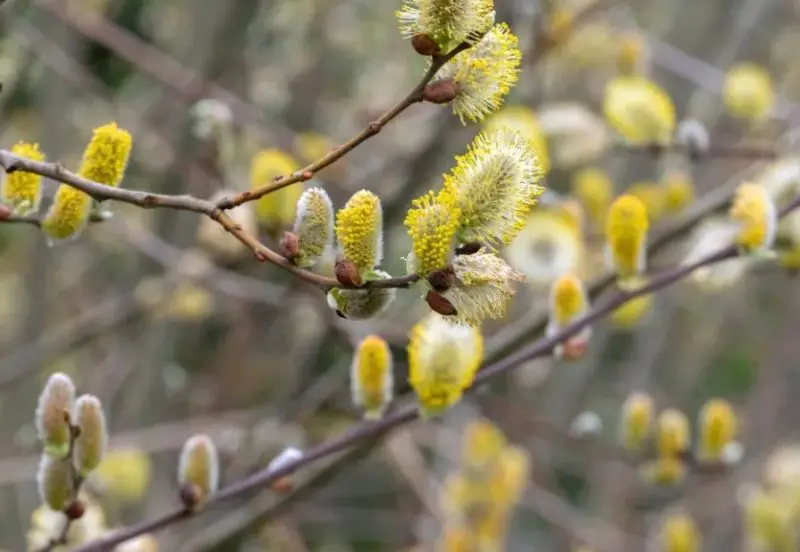
Goat Willow, also known as European Pussy Willow, is a small to medium-sized tree appreciated for its large, soft, silvery catkins that appear in early spring before the leaves. These fuzzy catkins are often one of the first signs of spring and are popular in floral arrangements. The tree has broad, rounded leaves and a dense crown.
Native to Europe and parts of Asia, Goat Willow grows best in USDA hardiness zones 4 through 8. It typically reaches heights of 20 to 30 feet and prefers full sun to partial shade. It thrives in moist soils but is more tolerant of drier conditions than many other willow species.
This willow is low-maintenance and benefits from occasional pruning to maintain its shape or remove older wood. It’s an excellent choice for wildlife gardens, providing early nectar for bees and shelter for birds. Its tolerance to a range of soils makes it suitable for both ornamental and naturalized plantings.
American Pussy Willow (Salix discolor)
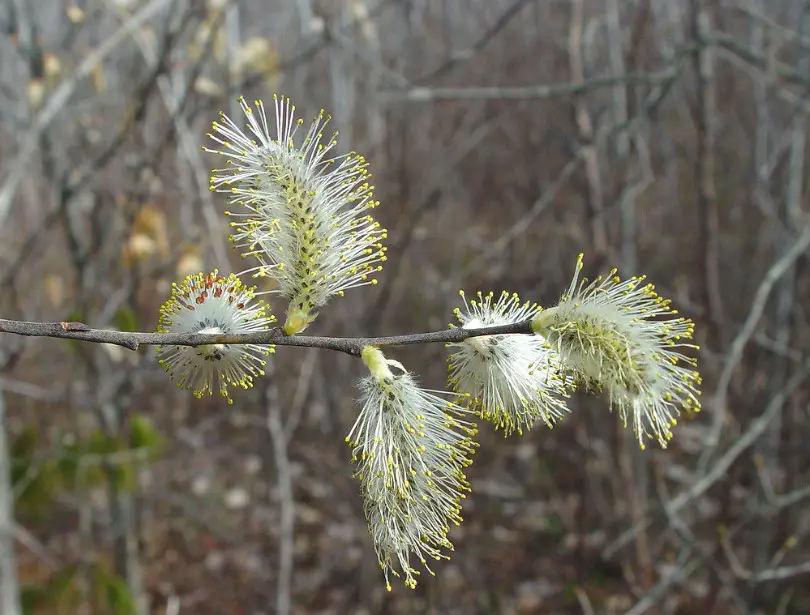
American Pussy Willow is a native North American shrub or small tree known for its attractive, silky catkins that emerge in late winter to early spring. The catkins, often gray or silver, are especially showy before the leaves unfurl, and they provide early-season interest in gardens and natural landscapes.
It is hardy in USDA zones 4 through 8 and thrives in full sun to partial shade. This willow typically grows 6 to 20 feet tall and is found in moist areas such as streambanks, swamps, and wet meadows. Its natural adaptability makes it ideal for use in native plant gardens and restoration projects.
American Pussy Willow requires little care beyond regular watering to keep the soil moist. It responds well to pruning and can be rejuvenated by cutting older stems to the ground. It’s a pollinator-friendly species and is frequently visited by bees in early spring.
Grey Willow / Common Sallow (Salix cinerea)

Grey Willow, also called Common Sallow, is a bushy shrub or small tree known for its soft, grayish foliage and fuzzy catkins that appear in early spring. The leaves are broadly oval with a silvery underside, and the plant often forms dense thickets in wet environments.
This species is native to Europe and western Asia and grows in USDA zones 4 through 8. It typically reaches heights of 10 to 25 feet and prefers full sun to light shade. It naturally occurs in wet woodlands, fens, and marshy ground and is often used in ecological restoration.
Grey Willow is easy to grow and tolerates a range of soils as long as they are moist. It benefits from regular pruning to manage its size and encourage new growth. Its dense form provides excellent habitat for birds and insects, making it valuable in wildlife-friendly landscaping.
Rosemary Willow (Salix elaeagnos)

Rosemary Willow is named for its narrow, lance-shaped leaves that resemble those of the rosemary herb. The foliage is a silvery green with a felted underside, giving the plant a soft, silvery appearance. It has a graceful, upright form and produces yellow catkins in early spring.
This species is native to Europe and parts of western Asia and is hardy in USDA zones 5 through 8. It usually grows as a large shrub or small tree, reaching 10 to 20 feet in height. It thrives in full sun and well-drained to moderately moist soils and is often found on riverbanks and hillsides.
Rosemary Willow is low-maintenance and drought-tolerant once established, making it suitable for more arid conditions than most willows. It benefits from pruning to maintain a tidy shape and can be used in ornamental landscapes, erosion control, or naturalistic plantings.
Common Osier (Salix viminalis)
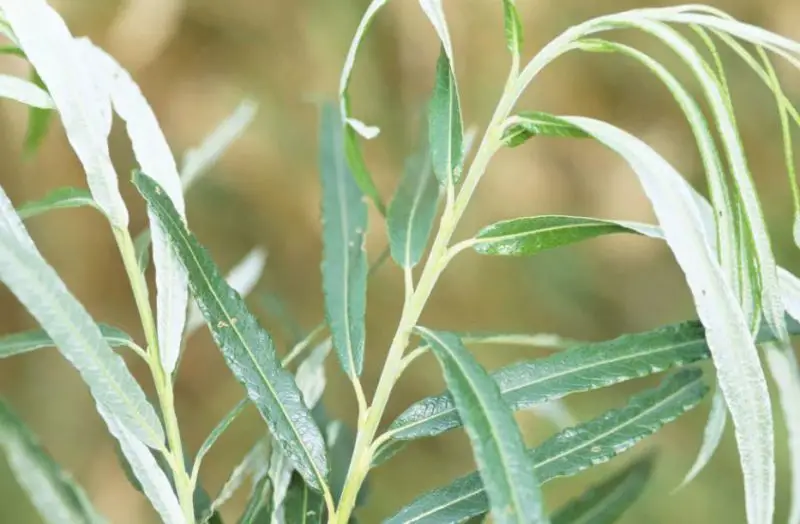
Common Osier is a fast-growing, medium-sized willow known for its long, flexible branches, which have historically been used for basket weaving. It has narrow, lance-shaped leaves that turn yellow in the fall, and its catkins are yellow-green, appearing in early spring. This species has a bushy, upright growth habit.
Native to Europe and Asia, Common Osier thrives in USDA zones 4 through 8 and prefers moist soils. It can reach a height of 15 to 25 feet and is often found along riverbanks, wetlands, and marshes. It is commonly used in riparian restoration projects due to its ability to stabilize soil and control erosion.
Common Osier is relatively low-maintenance and needs regular watering, especially during dry periods. It benefits from annual pruning to encourage fresh growth and to remove any older, weaker stems. It’s also an excellent choice for wildlife gardens, as its branches provide shelter for birds.
Red Hybrid Willow (Salix × rubens)
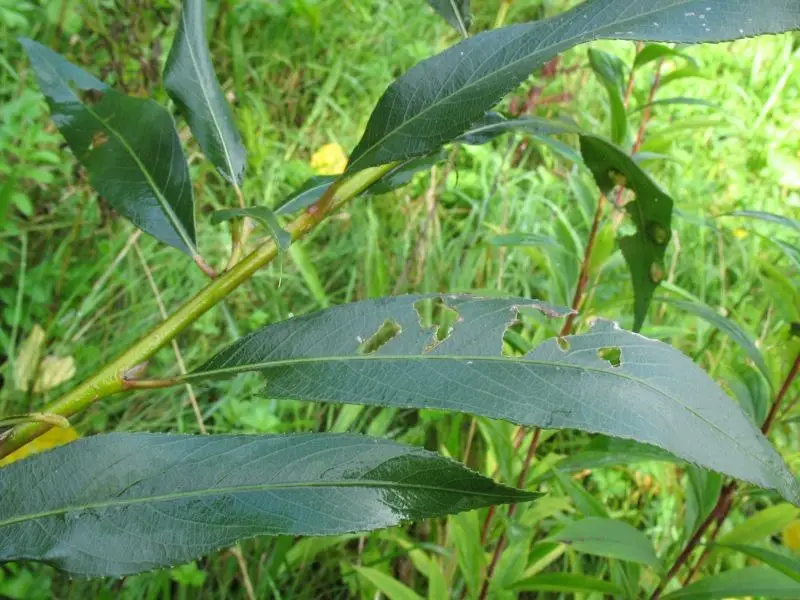
Red Hybrid Willow is a cross between different willow species, specifically bred for its fast growth and vibrant red stems. It has slender, narrow leaves and produces long, graceful catkins that appear in early spring. Its striking red bark is especially noticeable in winter, adding visual interest to landscapes.
Hardy in USDA zones 4 through 9, Red Hybrid Willow thrives in full sun and moist to wet soils. It can grow rapidly, reaching heights of 40 to 50 feet, and is often planted as a fast-growing screen or windbreak. This hybrid willow is commonly found in areas with ample water, such as along streams and rivers.
Red Hybrid Willow requires regular watering and is best planted in areas with plenty of space due to its fast growth. It may need pruning to keep its shape and remove any branches that have become too long or weak. It’s also effective at controlling erosion and can be used in restoration projects.
Russian Willow (Salix dasyclados)

Russian Willow is a tall, narrow willow with long, slender leaves that give it a graceful appearance. It produces fuzzy, yellow-green catkins in early spring, and the tree has a distinctive upright form, making it ideal for creating privacy screens or windbreaks. Its branches are flexible, often used for traditional basketry.
Native to Central Asia, Russian Willow is hardy in USDA zones 4 through 8 and thrives in full sun and moist, well-drained soils. It can grow up to 30 to 50 feet tall and is often found near rivers, wetlands, or in floodplain areas. It is well-suited for planting in riparian zones to help with erosion control.
Russian Willow benefits from regular watering, especially in dry periods, and responds well to pruning. It can be pruned to maintain a manageable size or to remove old wood. Its dense foliage provides excellent habitat for birds and other wildlife, making it a valuable addition to both ornamental and natural landscapes.
Basket & Coppicing Willows
Almond Willow (Salix triandra)
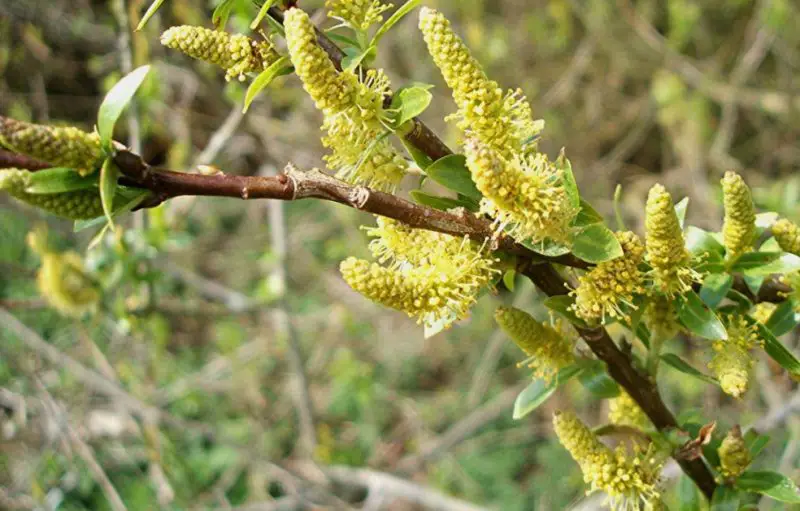
Almond Willow is a small to medium-sized tree known for its fragrant catkins that resemble those of almond trees. It has narrow, lance-shaped leaves that turn yellow in the fall, and its catkins are pale yellow, appearing in early spring. The tree has a dense, rounded crown and can develop a somewhat bushy appearance.
Native to Europe and parts of Asia, Almond Willow grows well in USDA zones 4 through 8, thriving in moist to wet soils. It typically reaches heights of 15 to 25 feet and is commonly found along riverbanks and in floodplain areas. It is often used in hedgerows, wetlands, and as an ornamental tree in gardens.
Almond Willow requires consistent moisture and grows best in areas with full sun or light shade. It benefits from regular pruning to shape the tree and remove any dead or diseased branches. This willow species is also known for its ability to attract pollinators, making it a great addition to wildlife gardens.
Smith’s Willow (Salix smithiana)

Smith’s Willow is a medium-sized willow tree known for its long, slender, lance-shaped leaves and its striking catkins, which appear in early spring. The leaves are glossy green on top and pale beneath, creating a textured, variegated effect. The catkins are yellow and cylindrical, adding to the tree’s ornamental appeal.
This willow species is native to parts of Asia and is hardy in USDA zones 4 through 8. It typically grows between 20 and 30 feet in height and thrives in moist, well-drained soils. Smith’s Willow is commonly found in riparian zones and along the edges of wetlands and watercourses.
Smith’s Willow requires regular watering, especially during dry spells, and grows best in full sun to partial shade. It can benefit from annual pruning to encourage healthy growth and maintain a manageable size. Its dense foliage and catkins provide a great source of food and shelter for local wildlife.
Japanese Fantail Willow (Salix udensis ‘Sekka’)

The Japanese Fantail Willow is a unique, ornamental variety known for its elegant, fan-shaped growth pattern and distinctive, weeping branches. The tree’s leaves are slender and light green, and its catkins are small and yellow, appearing in early spring. The weeping habit gives it a graceful, cascading appearance that makes it a favorite in gardens.
This willow is native to Japan and thrives in USDA zones 5 through 8, preferring full sun and moist, well-drained soils. It can reach heights of 15 to 25 feet, with a similar spread, making it a great choice for smaller landscapes or as a specimen tree. It is commonly used in ornamental gardens and as a feature in Japanese-style landscaping.
Japanese Fantail Willow requires regular watering, particularly in dry conditions. It responds well to pruning and can be shaped to enhance its unique fan-like form. This variety is also ideal for attracting pollinators and providing shelter for birds and other small wildlife.
Cold-Hardy / Arctic Willows
Polar Willow (Salix polaris)

Polar Willow is a small, hardy shrub that thrives in cold, northern regions. It features small, narrow leaves with a silvery underside, which gives the plant a distinctive frosty appearance. Its catkins are small, appearing early in spring, and the plant often forms low, compact mounds or dense patches in its native habitat.
Native to Arctic and sub-Arctic regions, Polar Willow is well-suited for USDA hardiness zones 2 through 6, growing in extremely cold environments. It typically reaches heights of 6 to 12 inches, often spreading through rhizomes to form low-lying ground cover. It is commonly found in tundra regions and on alpine slopes.
Polar Willow requires well-drained, moist soil and thrives in full sun or partial shade. Due to its low-growing nature, it requires minimal maintenance and is especially resilient in harsh climates. It can be an excellent choice for alpine gardens or as ground cover in cold, mountainous regions.
Grayleaf Willow (Salix glauca)
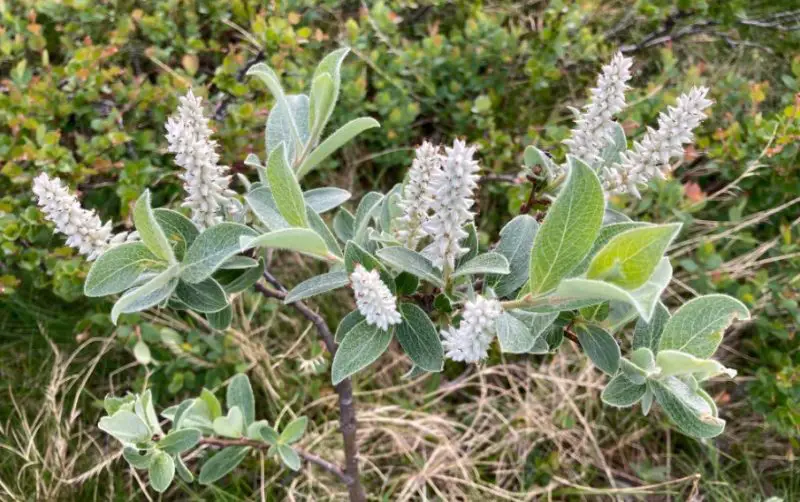
Grayleaf Willow is a small to medium-sized shrub with striking silvery-gray foliage. Its leaves are lance-shaped, with a pale, almost silvery undersurface that gives the tree its name. It produces slender, yellowish catkins in early spring, offering a delicate contrast against its soft foliage.
Native to the Arctic and subarctic regions of North America, Europe, and Asia, Grayleaf Willow is hardy in USDA zones 2 through 6. It typically grows 3 to 10 feet tall and is commonly found in wetlands, riverbanks, and boggy areas. It thrives in cold climates and is often used in wetland restoration projects.
Grayleaf Willow requires consistent moisture and prefers full sun or partial shade. It is relatively low-maintenance and benefits from occasional pruning to remove dead wood and encourage healthy growth. Its resilience in wet conditions makes it a valuable species for erosion control in riparian habitats.
Snow Willow (Salix nivalis)
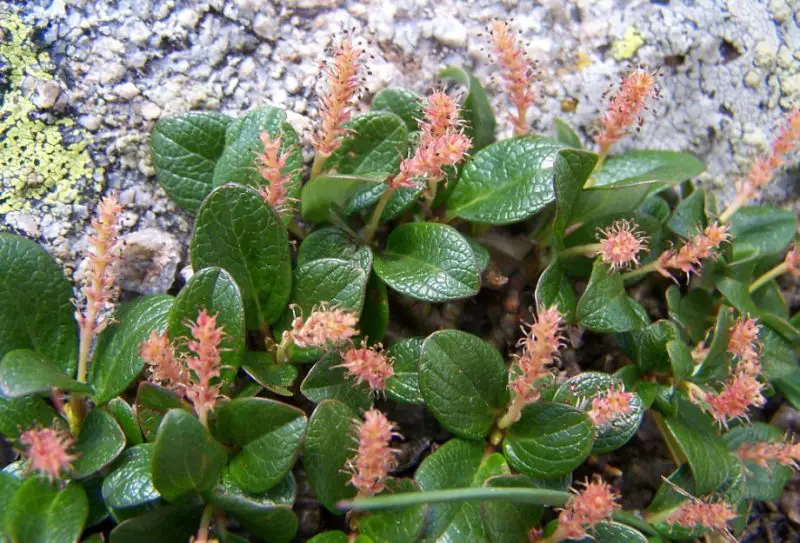
Snow Willow is a unique, low-growing shrub known for its small size and ability to thrive in extreme alpine environments. Its leaves are small and thick, with a pale underside, giving it a silvery appearance. The catkins are small and yellow, blooming in early spring, providing early-season interest in snow-covered landscapes.
Native to alpine regions in North America, Europe, and Asia, Snow Willow grows in USDA zones 2 through 6, making it ideal for cold climates. It typically reaches heights of 4 to 8 inches and spreads through creeping rhizomes, forming dense mats. It is most commonly found in high-altitude areas with harsh, snowy conditions.
Snow Willow thrives in well-drained, moist soil and requires full sun to perform best. Due to its small size and slow growth, it requires minimal care and is perfect for low-maintenance gardens or as ground cover in mountainous regions. Its ability to withstand snow and freezing temperatures makes it an excellent choice for alpine and tundra plantings.






